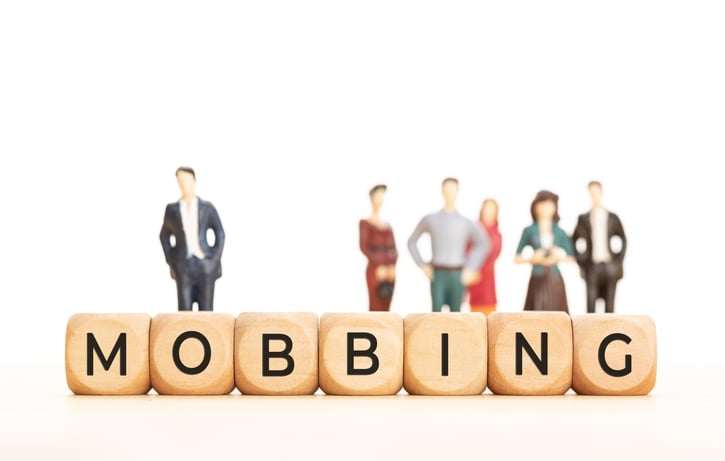What is mobbing?
Workplace mobbing refers to the targeted and persistent bullying behavior that an individual faces within their professional setting.
Unlike isolated incidents, this form of aggression often involves a critical mass of coworkers engaging in harmful actions, such as spreading rumors, emotional abuse, and deliberate isolation.
Such behavior, when unchecked, can have dire consequences on both the targeted individual's mental health and the overall morale of employees in the workplace.
Types of behaviors that constitute mobbing
Workplace mobbing behaviors encompass a range of actions designed to marginalize, intimidate, and emotionally harm the victim. These can include:
- Verbal abuse
- Exclusion from social events
- Spreading malicious rumors
- Undermining the target's work and achievements
The cumulative impact of these actions often leads to low self-esteem, anxiety, and depression for the victim, perpetuating a cycle of distress.
Useful Read: From Positive to Problematic: 12 Workplace Behavior Traits
Why does mobbing happen in the workplace?
Understanding the underlying reasons for workplace mobbing is crucial in addressing and preventing such behavior. Research shows that this phenomenon often stems from a combination of factors within the work environment and employee dynamics.
Some common reasons include:
Power struggles - Mobbing can arise from power dynamics, as perpetrators seek to assert control and dominance over others.
Jealousy and competition - Workplace mobbing may stem from jealousy and rivalry among colleagues, leading to harmful actions against a perceived threat.
Fear of change - Resistance to change within a team or organization can result in mobbing behavior directed at individuals advocating for change.
Group mentality - The anonymity and perceived safety within a group can lead to individuals engaging in bullying behavior they might not do individually.
Organizational culture - A toxic or competitive work culture can normalize mobbing behaviors, perpetuating the status quo.
Personal insecurities - Perpetrators' insecurities and low self-esteem can drive them to target others to boost their self-worth.
Organizational culture and its role in facilitating mobbing
Organizational culture significantly influences the occurrence of workplace mobbing. A toxic culture that fosters competition, gossip, and power struggles can provide a breeding ground for mobbing behavior.
When such actions go unchecked, they become normalized, perpetuating an environment where mobbing thrives.
Conversely, a positive culture that prioritizes respect, collaboration, and open communication is a deterrent to mobbing tendencies.
Nurturing an atmosphere where employees feel valued and supported and where accountability is upheld is crucial in preventing the emergence of workplace mobbing.
Group psychology: How mob mentality forms and escalates
Group psychology plays a crucial role in forming and escalating mob mentality within a workplace. When individuals gather in a group, they can be influenced by social dynamics that might not reflect their individual behavior.
Mob mentality often emerges when a shared belief or emotion, such as fear, anger, or conformity, spreads rapidly through a group. In the context of mobbing, this can lead to collective participation in harmful behaviors that individuals might not engage in independently.
The anonymity a group provides can further embolden individuals, leading to an escalation of bullying behavior.
Signs of mobbing at work
-
Behavioral changes in targeted employees often serve as initial red flags of the pernicious effects of workplace aggression, like group bullying. These individuals might display noticeable shifts in their interactions with co-workers, such as increased hesitancy in conversations or avoiding social engagements.
-
Decline in performance and productivity stemming from the psychological strain induced by ongoing mobbing is another prevalent sign. The toll is not limited to emotional distress; it extends to a tangible drop in work performance as they grapple with the aftermath.
-
Physical and emotional indicators of distress, including heightened stress and altered mood patterns, paint a vivid picture of the harm caused by mobbing. Recognizing these symptoms is vital to creating a positive work environment where mental health professionals and human resources collaborate to foster supportive solutions and effective conflict resolution mechanisms.
Addressing and preventing mobbing
Establishing clear anti-mobbing policies and procedures
This is a foundational step in eradicating workplace aggression and fostering a safe environment for all employees. Having comprehensive guidelines in place sends a strong message that other employees are protected and that perpetrators will face consequences for their actions.
This strategy involves creating a framework that empowers individuals to report incidents without fear and outlines the steps to be taken when mobbing targets seek help.
-
Accessible reporting channels: Ensure reporting mechanisms are easily accessible and well-publicized. This encourages individuals to come forward, knowing their concerns will be heard and addressed appropriately.
-
Investigation and action: Implement a thorough investigation process when incidents are reported. Taking swift action against perpetrators is crucial while ensuring due process, signaling the organization's commitment to accountability.
-
Awareness and education: Regularly educate employees about the anti-mobbing policies, the consequences of engaging in such behavior, and the support available for mobbing targets. This fosters a culture of collective responsibility and awareness.
Promoting a culture of respect, inclusivity, and open communication
A proactive approach shifts the focus from reacting to incidents to preventing them altogether. Organizations that prioritize respect and inclusivity create an environment where other employees actively maintain a positive atmosphere.
-
Inclusive practices: Encourage diversity and inclusivity in all aspects of the workplace, celebrating differences and ensuring that everyone feels valued.
-
Open dialogue: Foster an environment where open communication is valued. Regular team meetings and forums can provide spaces for discussing concerns, diffusing tensions, and addressing potential conflicts before they escalate.
-
Leadership role-modeling: Leaders and supervisors play a vital role in setting the tone for workplace behavior. When they exemplify respect and open communication, it sends a clear message to all employees.
Training programs for supervisors to recognize and address mobbing
Training ensures that individuals are equipped with the tools to identify and respond to signs of workplace aggression. By providing practical guidance, organizations empower employees to intervene effectively and promote a culture of support.
-
Early detection: Train employees to recognize subtle signs of mobbing and understand its psychological and emotional impact.
-
Empower bystanders: Teach employees how to intervene safely when witnessing mobbing, either by directly addressing the issue or by reporting it to appropriate channels.
-
Supervisor training: Equip supervisors with the skills to handle reports of mobbing sensitively, conduct unbiased investigations, and implement appropriate corrective measures, making them allies in the fight against mobbing.
By implementing these strategies, organizations can create a workplace where mobbing has no place, supporting the well-being of all employees and fostering a healthier and more productive work environment.
The role of collective efforts: Combating mobbing

In the battle against workplace mobbing, collective efforts play an instrumental role in effecting meaningful change. Initiatives undertaken by entities such as the workplace bullying institute and civil society publishing serve as platforms for raising awareness and fostering dialogue on this pressing issue.
Organizations, too, can play their part by conducting comprehensive workplace bullying surveys to gauge the prevalence of mobbing and tailor strategies accordingly.
-
Advocacy and research: The workplace bullying institute and similar organizations contribute by conducting research, compiling data, and disseminating insights into the pervasive nature of mobbing. By shedding light on this complex challenge, they pave the way for evidence-based interventions.
-
Resources for mental well-being: Recognizing the profound toll that mobbing can have on mental health, seeking support from a mental health professional is paramount. These professionals are equipped to provide targeted assistance to mobbing targets, aiding in their recovery and resilience.
-
Amplifying voices: Civil society publishing initiatives offer a platform for sharing personal stories and experiences, giving a voice to those affected by mobbing. This not only reduces the stigma surrounding the issue but also emphasizes the need for change.
In the larger context, addressing mobbing requires a multifaceted approach that brings together individuals, organizations, and support networks.
By acknowledging the tendency for mobbing and gaining insights from the findings of workplace bullying surveys, organizations can refine their strategies, create robust policies, and foster a culture of mutual respect.
Are there any legal regulations in the US regarding mobbing at work?
In the United States, there isn't a specific federal law that directly addresses workplace mobbing. However, workplace mobbing often falls under the broader categories of workplace harassment and bullying, which are covered by various federal and state laws.
Here are some key legal aspects related to mobbing at work in the U.S.:
-
Title VII of the Civil Rights Act - Title VII prohibits workplace discrimination based on race, color, religion, sex, and national origin. Harassment that creates a hostile work environment, including mobbing, can be considered a violation of this law.
-
Equal Employment Opportunity Commission (EEOC) - The EEOC enforces federal laws prohibiting workplace discrimination. Employees who experience mobbing can file complaints with the EEOC, alleging violations of anti-discrimination laws.
-
State anti-harassment laws - Many states have their own laws that address workplace harassment, which can include mobbing. These laws may cover a broader range of protected characteristics and provide additional protections beyond federal laws.
-
Occupational Safety and Health Administration (OSHA) - OSHA requires employers to provide a safe and healthy work environment. If mobbing creates a hostile or unsafe workplace, it might fall under OSHA's jurisdiction.
-
Retaliation protections - Whistleblower protections under various federal and state laws can shield employees from retaliation for reporting mobbing or other workplace misconduct.
-
Civil lawsuits - Mobbing victims might have the option to file civil lawsuits against perpetrators or employers for damages resulting from workplace harassment. Courts might apply common law principles or specific state laws to such cases.
-
Employer policies and contracts - Many employers have policies addressing workplace harassment, bullying, and mobbing. Employment contracts might also outline expectations for behavior and dispute resolution.
.png?width=323&height=124&name=img-16%20(1).png)
Employee scheduling and Time-tracking software!
Conclusion
Addressing workplace mobbing requires a collective commitment to employee well-being.
By recognizing signs, addressing root causes, and adhering to legal frameworks, organizations can foster cultures of respect.
Initiatives like the workplace bullying institute bolster the cause for change, ensuring workplaces become havens of dignity and mental health.


.png?width=323&height=124&name=img-16%20(1).png)





